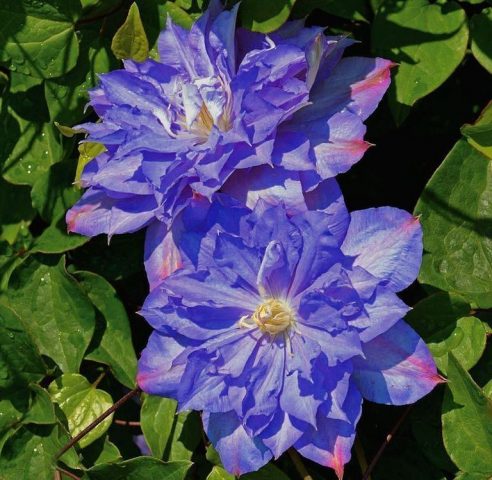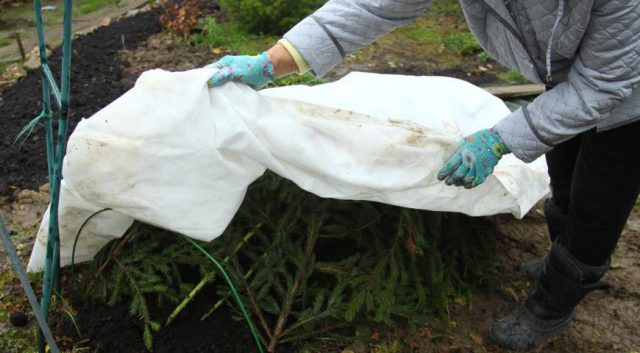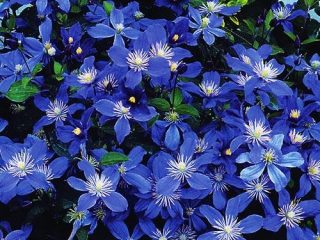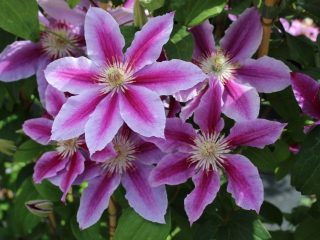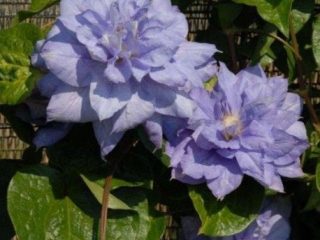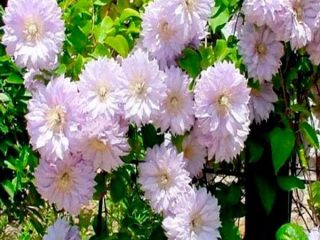Content
Clematis Blue Explosion is a flowering vine used as an ornamental plant. Clematis of this variety belong to large-flowered specimens, the vine of which beautifully braids the walls of the gazebo or support and blooms for a long time throughout the warm season (from May to September). The plant is used for vertical gardening.
Description of Clematis Blue Exploited
Clematis Blue Explosion (pictured) was bred by Polish breeder Sh. Marczyński in 1995. The plant belongs to the early large-flowered varieties.
Long-lasting, abundant flowering. From mid-May, last year's shoots begin to bloom, the second wave falls in mid-June and lasts until mid-September, at which time flowers form on young shoots.
The flowers of Clematis Blue Exploded are large double or semi-double on old shoots, simple ones on young branches, reach 15 cm in diameter, the shape is half-open, the color of the petals is blue with pinkish tips.
The height of Blue Exploited clematis reaches 2.5-3 m, therefore, when growing, it is necessary to install a support or any other structure along which the plant can crawl up.
Growing conditions for clematis large-flowered Blue Exploited
Blue Explosion Clematis loves sunny areas, but areas with periodic shading can also be used.
Blue Explosion belongs to the thermophilic varieties of clematis, so southern regions are suitable for its cultivation. Prolonged flowering of clematis implies a long and warm summer. In winter, the temperature in the region should not drop below minus 15 ° C, otherwise the culture will freeze.
Planting and caring for Clematis Blue Exploited
For planting young clematis seedlings, the spring period is suitable, when the threat of frost has passed. If a Blue Exploded seedling is purchased in the fall, it is planted 1.5 months before the onset of the first frost.
Clematis loves warm, sheltered from the wind, well-lit areas. There are some requirements for the soil: seedlings prefer neutral soils, but can grow in alkaline and slightly acidic areas.
For a seedling, a planting pit is preliminarily prepared. Standard hole sizes:
- on heavy lands - at least 70x70x70 cm;
- on light soils, 50x50x50 cm is enough.
Clematis Blue Explosion does not like dense plantings, so the minimum distance between the bushes should be 0.7 m. It is advisable to increase the gap to 1 m so that the plants do not compete for nutrients.
Waterlogged soil and stagnant water can lead to the death of clematis of this variety, therefore, watering should be strictly standardized.
The drainage layer must be at least 15 cm.
For filling in the planting hole, a nutrient soil mixture is prepared, consisting of the following components:
- sod land - 2 buckets;
- humus - 1 bucket;
- superphosphate or nitrophoska - 100 g.
Blue Exploded seedlings must be buried 6-8 cm into the ground, a small hole should be formed around the plant. On different soils, the degree of burial will differ. On heavy soils, the depth should be small, and on light soils up to 10-15 cm.
After planting, the plant needs pruning.On the shoots of Blue Explosion, 2 to 4 buds are left from below, the rest of the shoot is cut off. Pruning young plants is essential to strengthen the root system and improve root formation. If the seedling is planted in the ground in the spring, re-pruning is carried out after a few weeks.
After planting, the plant must be moistened. A well formed around the trunk will help retain moisture.
After watering, it is necessary to carry out mulching work. Sawdust or peat are used as mulching materials. Mulching a hole solves several problems at once: less water is required for irrigation, in addition, weeds cannot grow under a layer of mulch.
During planting or in advance, it is necessary to take care of the support for the Blue Exploded clematis. These flowers are quite tall, so you cannot do without supporting structures. You can buy them in a store or build them yourself, the main thing is to make them not only durable, but also beautiful, because clematis will not grow instantly. The optimum height of the supports should be between 1.5–3 m.
In the first days after planting, Blue Explosion seedlings must be shaded from bright sunlight.
You can feed clematis with mineral compounds, wood ash, mullein diluted with water. The bushes are fertilized no more than 1 time in 14 days. If mineral fertilizers are used, then 30 g are diluted in 10 liters of water. This volume should be enough for 2 m² of area. Wood ash will need 1 cup for each seedling. If you plan to use a mullein, then 1 part of the manure is diluted in 10 parts of water.
To protect the Blue Exploded clematis roots from overheating, the soil in and around the planting hole is planted with annual flowering plants; perennials can also be planted, but with a shallow root system. Calendula, marigolds, chamomile are the best options for landscaping the area around clematis.
Preparing for winter
Hybrid Clematis Blue Explosion refers to heat-loving plants, therefore, in the process of preparing the garden for winter, it is necessary to provide shelter for seedlings from bad weather and frost.
The best time for the procedure is the autumn period (just before the onset of frost). Cutting height - 100-150 cm from the ground. You can cut a little more if the branches are damaged or need rejuvenation. All weak and diseased shoots are cut off completely. After the procedure, the shoots are removed from the support and carefully laid on the ground, then covered with insulation and improvised means: spruce branches, peat, sawdust.
The first pinching of Clematis Blue Explosion is carried out at a level of 30 cm from the ground surface. The second time the procedure is repeated at a height of 70 cm, the third time the pinching is done at the level of 100-150 cm.
Reproduction
Clematis are propagated in various ways: by cuttings, layering, dividing the bush. The seed method of reproduction is the most unreliable and long-lasting.
Cuttings are harvested at the beginning of flowering plants. They are cut out from the middle part of the vine, while at least 2 cm should remain on top of the node, and 3-4 cm at the bottom.For fast root formation, cuttings are placed in a heteroauxin solution for a day, which is prepared as follows: diluted in 1 liter of water 50 g of the drug. Cuttings are planted obliquely in boxes. A mixture of sand and peat in equal parts is used as a soil. Cuttings root well in greenhouse conditions at temperatures no lower than plus 22-25 ºC. To create such conditions, cover the container with cuttings with a film. Rooting takes 1 to 2 months, then they are transplanted into individual pots. In winter, containers with seedlings are kept at a temperature not higher than plus 3-7 ° C. Watering occasionally, the main thing is that the earth does not dry out. In spring, this seedling is suitable for planting in a flower bed.Clematis grown by cuttings will bloom in the fall.
The layering method is as follows: the young shoot is bent to the ground and placed in a groove. To prevent it from being pulled out of the ground, in the places of internodes, it is pinned with metal wire and sprinkled with soil. The leafy tip should remain on the surface. Layers are watered regularly. As they grow, new internodes are also sprinkled with earth, leaving only a small top with a few leaves on the surface. For the winter, this layer is not dug up, but is left to winter together with an adult bush.
You can use two methods to divide the bush:
- dig out the bush completely and divide it into 2-3 parts, leaving at least three shoots on each root;
- dig in the roots of an adult plant on one side, separate part of the rhizome with shoots.
You can use any method you like.
Diseases and pests
Blue Explosion Clematis do not like waterlogged soil. If the soil is too wet, the roots are susceptible to fungal infections. Withering leaves, the appearance of spots on them indicate the development of a fungus. To prevent the death of the plant, it is necessary to treat the roots with foundation. 0.2% solution is poured under the root, this allows you to slow down the growth of pathogenic fungi.
The appearance of orange spots on leaves, shoots and petioles indicates the development of rust. To combat the disease, copper-containing solutions are used (Bordeaux liquid, copper oxychloride, polychem).
Pests that can parasitize clematis:
- aphid;
- spider mite;
- rootworm nematode.
Bears and mice can gnaw the roots, which is dangerous for the plant and can lead to its death.
Slugs and snails can also harm young clematis seedlings, so it is necessary to deal with them. Mulching the tree trunk circle with spruce needles can prevent the problem of slugs and snails.
Conclusion
Clematis Blue Explosion can decorate any garden area. With the right choice of a planting site and appropriate care, clematis will delight with abundant flowering annually.
Reviews about Clematis Blue Explosion
